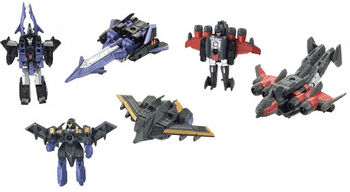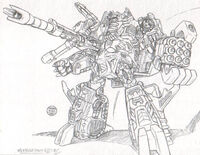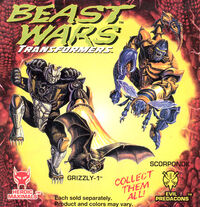
The Air Military Team from Armada. The gimmicks: micro-size, ability to "powerlinx" with larger toys, triple-changing, being awesome.
In contrast to most science fiction franchises, toys are the core of the Transformers brand, its original reason for being. Most Transformers fiction exists to showcase, spotlight, promote, and in general to sell toys. Merchandise and other non-transforming "artifacts" also generally exist in support of the toy lines.
Transformers toys are generally created and marketed as part of a particular "franchise" (i.e. Beast Wars, Armada, the retroactively-named Generation One etc.), a whole merchandising family with associated characters and fiction. However, this article deals with the physical toys themselves, separate from their representation as fictional characters.
Since the brand debuted in 1984, innumerable Transformer toys have been designed, manufactured and marketed. An exact count is difficult due to the varied nature of the toys (for example, does a Headmaster robot and its partner mini-figure count as one Transformer or two? What about minor retools and running changes?) But even conservative estimates by collectors tend to run into the low thousands.
Design[]

Where the hell do you KEEP that enormous cannon, Megatron?
Most Transformers are designed as a joint venture between Hasbro in America, and TakaraTomy (previously Takara) in Japan. Hasbro typically provides concepts and artistic direction, while Takara(Tomy) handles the engineering tasks of turning the designs into working physical objects. This division of labor is not cut-and-dried, however; the process involves a great deal of back-and-forth communication between the two companies, with staff members from both working in close conjunction and corresponding on a daily basis. The teams travel overseas several times a year to meet in person, alternating between Japan and Rhode Island. The relationship has grown closer and more intense over the years; the two companies now plan their futures together, compromising along the way to meet the differing requirements of their target markets; this includes not only to toy designs, but associated storylines as well.[1]

Design concepts for an unproduced Classics Cosmos. If Hasbro makes this, fans will have their babies.
The toy design process begins with a range of character types and possible alternate modes. In the days of Beast Wars, for example, a range of about 100 animal forms was considered.[2]
Nearly all Transformers toys have a minimum of two forms, most commonly a humanoid "robot" form and an alternate mode. This means that even a fairly simple Transformer is much more complex than the typical action figure. Multiple alternate modes, articulation, and complex transformations can multiply this many times over. TakaraTomy works out the transformation schemes; as of 2002, Takara still did this on paper. Hasbro would then overlay their detailing designs on the drawings. The entire process of taking a toy from concept to finished, mass-produced product takes approximately one year.[3]
Because of their worldwide marketing, Transformers must be designed to meet many widely-varying safety laws. This often results in certain limitations, and even changes being made before toys are sold in the highly litigious United States of America compared to their Japanese releases.
Related articles:
- Hasbro
- Takara
- Playskool
- Tonka
- Play pattern
- For safety reasons
- Transformation (toys)
- Alternate mode
- Licensed vehicle alternate modes
- Instruction booklet
- Scale
- Kibble
- Shellformer
- Partformer
- Unreleased toy
Components[]

Gone are the days when the instructions said, "Flip out rear of vehicle to form legs; pull out arms."
Transformer toys contain a "vocabulary" of working parts, joint types, and standardized design items that reappear across many figures. The vast majority are humanoid in their robot mode, and thus require a head, (at least) two arms, two legs and a torso.
The complexity of Transformers toys has grown over time, making several leaps forward during the course of Generation 2 and Beast Wars, and then again during the Movie line. G2 introduced complex posability and the notion of toys that could store or hold all of their accessories in both modes; Beast Wars made these concepts universal, and featured a number of toys with extremely complicated transformations and a maximum number of ball joints, providing a huge range of articulation. Other toy lines would revisit these levels of complexity, particularly Robots in Disguise and Alternators.
Related articles:
- Articulation (see also: Brick)
- Ratchet (mechanism)
- Slide joint
- Swivel joint
- Ball joint
- Peg
- Hardpoint
Production/Manufacturing[]

Though the toys are designed in America and Japan through a collaborative process between Takara and Hasbro, most are manufactured in places like China.
The production process is complex and expensive. Before mass production can begin, a hard-copy prototype must be created. Steel-cut molds can then be made; this is by far the most costly part of the process. Once the molds are cut, one or more test shots are typically created, usually in random colors. If the molds are ready, mass production commences.
The expense of cutting molds is the main reason that retools and recolors are such a common phenomena in Transformers. Recolors allow Hasbro and TakaraTomy to capture a greater return on their considerable investment.
Related articles:
- Prototype (includes test shots)
- Mold
- Gang-molding
- Retool
- Sprue
- Running change
- For safety reasons
- Pre Rub
- Unreleased toy
Materials[]

Tracks from the Alternators/Binaltech line. The Japanese version uses die-cast metal for added heft, while the American iteration is all-plastic for added being-able-to-stand-up.
The vast majority of the toys are made of plastic, held together with metal screws and pins, along with the occasional adhesive. The plastics used in Transformer construction have generally increased in flexibility and durability over the years, allowing toys to survive child-inflicted trauma that would have destroyed early Generation One toys.
Die-cast, used as an accessory material from 1984-1986, has been all but abandoned due to its excessive cost, shipping weight and design limitations, though it has reappeared in the fan-oriented Binaltech and Titanium Series sublines.
Related articles:
Common gimmicks[]

Not much articulation, but man, can he scoot across your kitchen floor.
As if Transformers weren't complicated enough, Hasbro has seen fit to revitalize and enhance the line constantly with numerous special features, commonly referred to in the fandom as gimmicks. These may range from things as simple as a common decorative theme (such as vacuum metalizing on the Transmetal toys) to complex mechanisms that drive the entire design of a toy. Gimmicks have been a part of Transformers from Day 1 and continue to provide the line with diversity and interest today.
Static gimmicks[]
Active gimmicks[]
- Missile
- Pull-back motor
- Autotransform
- Flipchanger
- Sparking gimmick
- Soundbox
- Light-emitting diode
- Combiner
- Mini-Con
- Cyber Planet Key
- Automorph
Decoration[]

OTFCC-exclusive Sentinel Maximus, a toy heavily slathered in paint applications.
Most Transformers are cast in a limited number of plastic colors. To help bring them to life, paint, tampographs, and stickers are commonly used to provide additional color.
Stickers were common during the days of Generation One, but have mostly dropped out of use due to changing aesthetic tastes and the feasibility of more complex paint operations. Today, faction symbols are typically applied via tampograph, with most other details brought out by paint applications.
Related articles:
- Sticker
- Paint application
- Paint mask
- Vacuum metalizing
- Unpaintable plastic
- Tampograph
- Redeco
- Repaint (see also: Black repaint)
Marketing[]

In the market-driven rush to production, sometimes the wires get a little crossed. This package cross-sell presents other toys in the line... in color schemes that were never mass-produced. Oops!
As awesome as the toys themselves may be, they tend to sell better when they represent fictional characters. The marketing engine that promotes the toys is organized into franchises, each encompassing a range of related toys with a storyline built around them. A full-blown, flagship franchise typically features an animated cartoon, and often a comic book series as well. These fictional portrayals may also be a source of considerable income for Hasbro/TakaraTomy, but ultimately they exist to sell toys.
The toy packaging also commonly supports the marketing effort, with biographies and package art of the characters, as well as cross-sell ads promoting other toys currently available. Inside the packaging, catalogs and pack-in flyers further market other toys.
Related articles:
- To sell toys
- Commercial
- Franchise
- Show-accuracy
- Trademark
- Tech spec
- Bio
- Package art
- Instruction booklet
- Catalog
- Cross-sell
- Pack-in flyer
- Robot point
Distribution and retail[]

Packaging! It's elegant, sleek, attractive, and lasts for about five seconds.
Once the toys are manufactured and packaged, they are shipped from their place of birth in Asia to America. As of 1998, their first destination is a Seattle distribution warehouse. From there, they proceed to the distribution centers for the various chain stores that sell the toys at retail; at that point, control of distribution is out of Hasbro's hands. On average, it takes six to eight weeks from the time the toys ship from Hasbro to their appearance on retail shelves.[2]
Toy retailers do their best to predict what toys will and won't sell, and order accordingly; however, it is an imperfect process, and slow sellers in one wave of toys can compel a retailer to order fewer toys from the following waves. Retailers are particularly reluctant to order large numbers from the tail-end of a toy line.[1]
Today, the largest distributors of Transformer toys in America are Walmart, Target, and Toys "R" Us, though the toys can also be found at many other stores such Meijer, Kmart, KB Toys, Kohl's, and Walgreens, as well as various regional grocery and drug store chains.
Related articles:
- Packaging
- Wave
- Size class
- Market six
- Multilingual packaging (see also: JaAm)
- Rebranding
- Subline imprint
- Black Friday
- Exclusive
- Shortpacking
- Blindpacked
- Chase figure
- Shelfwarmer
Secondary market[]
In Transformers fandom, "secondary market" refers to the buying and selling of used toys. The original, stereotypical secondary market was the old-fashioned garage sale — you know, the one where your mom sold all your G1 toys for ten bucks while you were off in college.
The secondary market among fans began with internet auctions, primarily on alt.toys.transformers in the early 1990s. By the late '90s, ATT's primacy as a marketplace had been supplanted by eBay and various fan-run sites. Buyers and sellers also found a bonanza of opportunities at BotCon, with thousands of toys changing hands over the course of a weekend.
Like any economic market, the secondary market has a life of its own. Older toys can be worth hundreds of dollars, depending on their condition, rarity, and popularity, or they may be worth next to nothing. Most toys from Beast Wars and later franchises tend to be of comparatively lower value, as many adult fans were buying the toys when they were at retail, and have since kept them in pristine or even unopened condition.
Related artcles:
Toy aging[]

Split open and melt.
Transformer toys are, to put it bluntly, not meant to last forever. They are marketed to a fleeting and transitory age group, with the notion that if they survive a few years, their work is done. Thus collectors who have retained Generation One toys for many years can find some unexpected surprises as their toys age, regardless of how carefully the toys have been stored. Among the most common problems are:
- plastic discoloration — see Photodegradation
- cracking of rubber tires and the rubber tubing on Shockwave, also known as Ozone Cracking. Damned organics.
- deterioration of the Pretender Monsters' rubber Pretender shells
- chrome flaking, a problem common on the Transmetal toys — see Vacuum metalizing.
- deterioration of sub-par plastics that can cause a toy to physically disintegrate — see Gold Plastic Syndrome.
External links[]
[1]Transformers Action Figures and Collectibles
